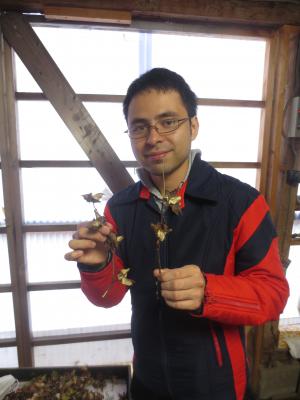This weekend I had an opportunity to explore Fukushima for the first time.We traveled through Koriyama, Kitakata City and Aizu Wakamatsu This was no ordinary tour as it was created to give a person like myself a real idea of how business and agriculture carry on post-disasters. We all were eager to see and learn. The very first place we visited was the Fukushima Agricultural Technology center located in Koriyama. This is a laboratory where agricultural items get tested for radiation levels and safety. This place is usually very busy with the responsibility of checking all vegetables and agricultural items in the prefecture for safety and quality. All of the equipment in regards to monitoring radiation levels are quite new and imported from the US. The services are provided free of charge to farmers in Fukushima, and almost everyone takes advantage of this. If one does not, you can imagine that this farmer would lose trust from his local community. Simply put, nobody would buy from that farmer. So there is great incentive. Japanese government standards for radiation levels are actually much more strict than Europe and the US. In general, I would say that I feel pretty good about the work they do, and I am not opposed to eating most food here. We had some cultural activities throughout the day as well. We painted cute, little okiagarikoboshi. We also spent time at the impressive Tsurugajo Castle and learned about its history. There were also informative visits to a sake brewery and storehouses too. All the while we drove the Aizu countryside. It was full of mountains and fields. I had my first glmpse of Lake Inawashiro and Mount Bandai. During our time in Kitakata city, we were able to enjoy incredibly delicious ramen. I have ate very well during this tour! The best part of the trip was the farm-stay. We had a chance to stay with a farmer and help out with the chores. In turn they would provide us with accommodation for the night and two feasts! We talked and ate delicious food with our hosts for hours! They were very hospitable. Unfortunately, it rained in the morning. There were plans to help pick vegetables and fruits, but it wouldn’t be possible after all. Instead we helped pick out the seeds in the cotton that was collected. This was fine since it could be done indoors. All in all, it was an excellent trip. I learned a great deal about what is being done with food and consumable items in Fukushima these days. It is still hard to grasp the scale of what has happened here. The 2011 earthquake/tsunami and subsequent nuclear plant disaster have affected everything. People do their best to carry on with their lives and work through the changes. I met many people continuing with their lives and working with traditions and safety in mind. I can see that easily, because it is happening all around. Thank you for putting this trip together! |  |
| Summary |







